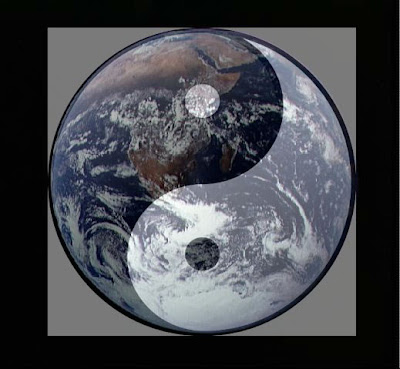 |
| Gregory Bateson, photographer. Margaret Mead and Gregory Bateson working among the Iatmul, Tambunam, 1938. Gelatin silver print. |
LANGUAGE COMMONLY STRESSES ONLY ONE SIDE OF ANY INTERACTION
We commonly speak as though a single "thing" could "have" some characteristic. A stone, we say, is "hard," "small," "heavy," "yellow," "dense," "fragile," "hot," "moving," "stationary," "visible," "edible," "inedible" and so on.
That is how our language is made: "The stone is hard." And so on. And that way of talking is good enough for the marketplace: "That is a new brand." "The potatoes are rotten." "The eggs are fresh." "The container is damaged." "The diamond is flawed." "A pound of apples is enough." And so on. But this way of talking is not good enough in science or epistemology. To think straight, it is advisable to expect all qualities and attributes, adjectives, and so on to refer to at least two sets of interactions in time.
"The stone is hard" means a) that when poked it resisted penetration and b) that certain continual interactions among the molecular parts of the stone in some way bond the parts together.
"The stone is stationary" comments on the location of the stone relative to the location of the speaker and other possible moving things. It also comments on matters internal to the stone: its inertia, lack of internal distortion, lack of friction at the surface, and so on. Language continually asserts by the syntax of subject and predicate that "things" somehow "have" qualities and attributes. A more precise way of talking bout insist that the "things" are produced, are seen as separate from other "things," and are made "real" by their internal relations and by their behavior in relationship with other things and with the speaker.
It is necessary to be quite clear about the universal truth that whatever "things" may be in their pleromatic and thingish world, they can only enter the world of communication and meaning by their names, their qualities and their attributes (i.e., by reports of their internal and external relations and interactions).

"The stone is hard" means a) that when poked it resisted penetration and b) that certain continual interactions among the molecular parts of the stone in some way bond the parts together.
"The stone is stationary" comments on the location of the stone relative to the location of the speaker and other possible moving things. It also comments on matters internal to the stone: its inertia, lack of internal distortion, lack of friction at the surface, and so on. Language continually asserts by the syntax of subject and predicate that "things" somehow "have" qualities and attributes. A more precise way of talking bout insist that the "things" are produced, are seen as separate from other "things," and are made "real" by their internal relations and by their behavior in relationship with other things and with the speaker.
It is necessary to be quite clear about the universal truth that whatever "things" may be in their pleromatic and thingish world, they can only enter the world of communication and meaning by their names, their qualities and their attributes (i.e., by reports of their internal and external relations and interactions).









































